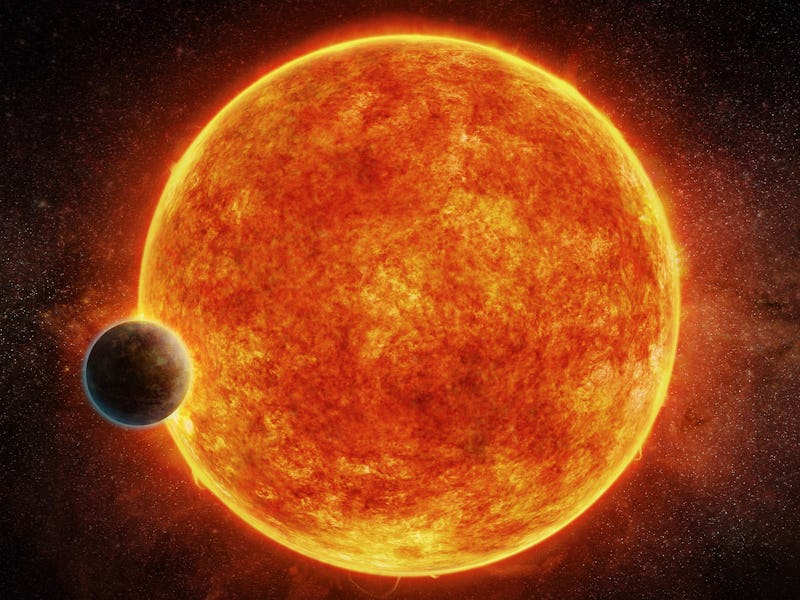The discovery of the new potentially habitable planet, LHS 1140b, seemed to burst from out of nowhere. Perhaps even less expected was the notion being pushed that the little super-Earth, 40 light-years away, could be the scientific community’s best chance at finding alien life.
You’re probably thinking, “Yeah but haven’t we heard this same claim being spouted before?” And you’d be right — sort of. In just the last year, we were blessed with news about the closest exoplanet to Earth, Proxima b, at just 4.25 light-years away being potentially habitable. Then the TRAPPIST-1 discovery upped the ante with seven potentially habitable planets.
But there’s more hope that LHS 1140b possesses better odds of hosting life than those other two systems — and it all comes back to atmosphere. The research team that discovered LHS 1140b thinks the large size of the planet along with other bits of data suggest the planet might have a sustained atmosphere — key to ensuring the surface temperatures are amenable for liquid water, and therefore life.
Apart from all that, however, the discovery is further proof of a real trend in the last decade for exoplanet scientists to embrace the potential for red dwarf stars in the search for habitable worlds and extraterrestrial life.
Red dwarfs are everywhere, making up an estimated 80 to 90 percent of the stars in our neighborhood of the Milky Way galaxy. Scientists are particularly jazzed about M dwarfs — ultra-small, long-lasting, and somewhat cooler. Aomawa Shields, an astronomer at UCLA, told attendees at the Breakthrough Discuss Conference in Palo Alto on Thursday that M dwarfs are like tortoises of the stellar family, aging slowly but steadily, possessing enough time as stable bodies to help foster planetary systems with real potential for habitability.
And of course, with so many of them around, M dwarfs “offer the best chance of finding habitable planets through sheer numbers alone,” said Shields. Harvard University astronomer Courtney Dressing mentioned that many astronomers jokingly call them “the vermin of the sky.”
Well, these vermin are extremely important if we want to find habitable planets. According to Dressing, based on data gathered by the Kepler spacecraft from 2009 to 2013, there are an estimated 2.5 planets for every M dwarf star. Another 25 percent of those planets likely host a small, cool, Earthlike planet.
While the odds favor looking for Earth 2.0 by concentrating on M dwarfs, there’s another practical incentive as well — they are much easier to look at for detecting signals of exoplanets. Dressing explained that smaller stars are easier to observe for transit signals — in which there’s a dimming of light emitted by a star due to passing of a smaller object in front. This dimming, if it occurs regularly, is a sign of a planet — and it’s easier to find these signals in front of M dwarfs than bigger stars like the sun.
That transit data is able to tell us more than whether there’s simply an exoplanet in the vicinity. Scientists can use the rate of light being blocked, and measure the amount of light being absorbed or reflected, to determine orbital period, mass, size, and the presence and composition of an atmosphere. The LHS 1140 and TRAPPIST-1 systems — both with M dwarf host stars — are two of the first from which astronomers have measured planet density.
But it’s the potential to study atmosphere why the hype around LHS 1140b is justified. David Catling from the University of Washington is heavily invested in studying how to leverage current technologies to look for biosignatures (i.e. signs of life and habitability) within exoplanet atmospheres. He cites one methodology which could prove very useful: chemical disequilibrium.
Basically, many kinds of elements and compounds in the air ought to react with one another over time. If there are heavy concentrations of two types of gases that don’t seem to be reacting, it could be a sign that life is present. For example, oxygen and methane should react to produce carbon dioxide and water. If it turns out there are heavy concentrations of both oxygen and methane in the air, it might mean some lifeforms are responsible for contributing to those airborne concentrations.
Catling still thinks oxygen is the best bet for biosignature assessment. It’s simply too essential to life and too important to our current notions of habitability to ignore.
Harvard’s Mercedes López-Morales would agree. She told the audience on Thursday that detecting oxygen in the atmosphere is not really a difficult process — it just takes time. The world’s ‘extremely large telescopes’, like the upcoming Giant Magellan Telescope (GMT) and the European Extremely Large Telescope (E-ELT) are prime pieces of equipment for collecting data on an exoplanet and learning whether it possesses atmospheric oxygen.
The catch: using only one of these telescopes alone, like the GMT, would probably take about five to six years to really confirm the presence of oxygen. “Right now, we are photo-limited,” said López-Morales. Her presentation was basically an appeal for the world’s scientists to use the world’s three upcoming ELTs in concert to study planets like LHS 1140b — in which case the timeframe of study cuts down to about a year.
Imagine — the single greatest discovery in the history of the species, in which we learn we are not alone in the universe, might all come down to simply focusing our biggest telescopes on one or more planets that seem Earth-like. Will that actually happen? Those odds are only slightly better than actually finding alien life.
